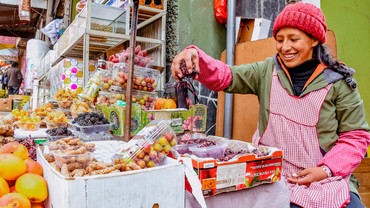We need to safeguard biodiversity and promote diverse diets
Coinciding with this year’s International Day for Biodiversity, a new report from IIED and Hivos explores how we can reverse the alarming loss of biodiversity in agriculture and foster diverse diets.


Many crops today are grown in monocultures like this soybean field (Photo: via Pixabay)
Agricultural biodiversity underpins diverse, nutritious diets – which are essential to human health. However, global shifts in food production and dietary patterns are threatening agricultural biodiversity.
Diversity at risk
Agricultural landscapes are becoming increasingly simplified as the number of crops and crop varieties grown on farms diminishes. Declining diversity on the land coincides with increasing homogenisation of diets. Today 30 crops supply 95% of the calories that people obtain from food, and only four crops – maize, rice, wheat and potatoes – supply over 60% (PDF).
This unprecedented and growing reliance on an increasingly narrow range of crops, crop varieties and animal breeds bring long-term risks for biodiversity. It also undermines the ability of agriculture to adapt to climate change, because many local crop varieties and animal breeds are more resilient than the modern ones that are replacing them.
The food paradox: calories aplenty but diets remain poor for many
More than enough food is produced globally to provide sufficient calories for every person on the planet. Yet at least three billion people have low quality diets which either lack sufficient calories, vitamins and minerals or contain too many energy-dense, nutrient-poor foods that are high in sugar, salt and fat.
How can we address the problems of low quality diets and agrobiodiversity loss? To coincide with this year’s International Day for Biodiversity, a new IIED and Hivos paper explores the connection between agricultural biodiversity and diverse, high quality diets, why they are both at risk and what can be done to foster them, particularly in developing countries.
Does diversity on the farm lead to diversity on the plate?
One key question is whether diverse farms lead to diverse, healthy diets. For one farmer we interviewed in Zambia the links were clear: “when you have a variety of crops in the field (and foods on the table), it means you are preventing some diseases in your body. It helps body building. So it will help your family.”
Substantial evidence from academic literature suggests diverse agricultural production contributes to dietary diversity in farm households in developing countries. However, this relationship is complex and is mitigated by markets and other factors such as gender and control over resources, wealth, cultural values and the existing degree of on-farm diversity.
While diverse production systems should be encouraged – both for reasons of sustainability and dietary quality – other factors must be considered to ensure diverse and healthy food consumption. One cannot assume that diverse agricultural production automatically leads to diverse consumption. For instance, farmers may be growing a variety of crops but selling most of them to meet urgent needs for cash, as is the case with some farmers in Fort Portal, Uganda.
How women can foster diversity ̶ on the plate, and on the land
Women produce, purchase and prepare food, and their food choices influence the diversity of diets of their families and in turn can determine which crops are grown to feed their communities.

A review of 15 different studies (PDF) found stronger links between agricultural biodiversity and dietary diversity in female-headed households than those headed by males. A study in Nepal found that when women had greater autonomy in production and working hours, maternal and children’s dietary diversity improved.
There is also evidence that when women have control over resources such as land and money, it leads to greater allocations of household resources for food. Empowering women is clearly key. In Indonesia, IIED and Hivos are working with the grassroots organisation Tanoker, which is promoting diverse, healthy diets among local communities in Jember Regency.
Tanoker is running informal training programmes to empower mothers and improve their knowledge of nutrition. Food diaries – where participants record the foods they eat for a seven-day period – are being used to map dietary patterns in the region.
What else can be done?
Reviving and maintaining diversity on the farm and on the plate requires action on multiple fronts and at multiple scales. At a macro level, promoting diversity calls for a shift from industrial agriculture – increasingly characterised by monocultures and a small number of crops, crop varieties and animal breeds – to diversified sustainable farming systems.
At a national and local scale, government, civil society and the private sector need to work together to raise awareness and stimulate demand for diverse, healthy foods, to rebuild and expand the markets that support diverse crops and animal products. Meanwhile, policies, subsidies, research and extension programmes need to be aligned to support diverse food production and consumption.
Finally, we need to protect and strengthen the knowledge and cultural practices that support diverse food systems, which are also under threat worldwide. Inclusive governance models and multi-stakeholder approaches can help to achieve all of these ends, particularly when they use and build upon citizen’s knowledge and practices to re-shape food systems.
The Sustainable Diets for All programme is working to help low-income communities in Bolivia, Indonesia, Uganda and Zambia improve their access to diverse, high quality, sustainable food. This five-year (2016-20) programme is coordinated by Hivos, IIED, and partners in the focal countries.




